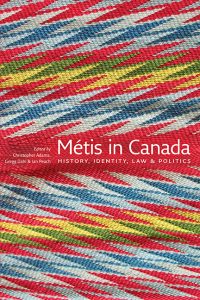In a national census 409,065 Canadians identify themselves as Métis. They represent the 18th largest “ethnic” group in the country after Portuguese, Norwegians and Filipinos. Of course the Métis are unique, with centuries-old roots that define much of the nation’s history.
And yet –
Métis are iconic figures of Canadiana famed as self-reliant hunters, but they have spent the past forty years in court determining their aboriginal rights. Métis are a nation, but for centuries had no constitution or identifiable self-government.
As people of aboriginal and European descent, Métis rely on self-identification to count their numbers. Yet “a person can identify as Métis and not be legally entitled to exercise the Métis Aboriginal right to hunt for food,” note editors of Métis in Canada; “Furthermore, being legally entitled to exercise the Métis right to hunt for food does not necessarily indicate that such a person is also a member of a Métis political organization.”
Still, there is a uniquely Canadian logic to it. Everyone knows what is meant by the term Métis, and the people themselves are defined exactly by what they are not. The editors put it succinctly: “About the only elements that tie this diversity together are the facts of the Métis peoples’ distinctiveness – from other Indigenous peoples and from the settlers – and their constitutional recognition as rights-bearing, indigenous peoples in Canada.”
This University of Alberta press selection chronicles the unique Métis contribution to the Canadian story. The late Helen Bradley, former senator of the Georgian Bay Métis Council, recalled her childhood in the 1930s as the daughter of an Ojibwe-speaking father from Drummond Island and a French-speaking mother from Québec: “Mom would always say she didn’t have any native blood. Remember the Indian List? They couldn’t go into hotels. The Indians were getting bad names because of that; that’s why, I think, they didn’t want us to let on that we had native blood in us.”
Underscoring the story of the Métis is the vulgar term “half-breed”, still popular till recent times. As late as 1958 the parliamentary bureau of The Canadian Press referred to “half-breeds” in everyday coverage of federal bills affecting aboriginal land rights; as late as 1972 history schoolbooks approved for use by Ontario’s Ministry of Education approved history texts that cited “half-breeds” as a fixture of pioneer life.
In 1885 John A. Macdonald said, “If they are half-breed they are white.” Well, not exactly; Métis in Canada recounts an 1869 traveller’s telling observance that “half-breeds are a sort of half-and-half specimen of humanity, hardly entitled to the privilege of being called rational beings”; “The word ‘half-breed’ merely signifies where there is a tinge more or less of Indian blood – but whoever started the term ‘breed’ ought to have been choked before he had time to apply it to human beings.”
By Holly Doan
Metis in Canada: History, Identity, Law & Politics edited by Christopher Adams, Gregg Dahl & Ian Peach; University of Alberta Press; ISBN 9780-8886-48112; $52






